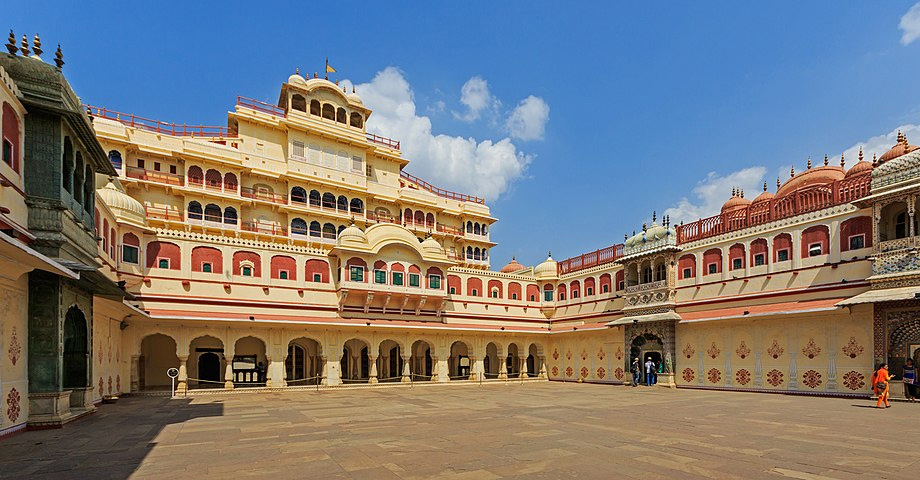- Have Any Question ?
- +91-9929358785
- 01414054824
- Info@thepinkcityholidays.com
City Palace Jaipur (Entry Fee, Timings, History, Images, Location & Entry Ticket Price)

Albert Hall Museum Jaipur, India (Entry Fee, Timings, History, Images, Location & Entry ticket cost price)
June 1, 202510 must-see places in India
August 11, 2025City Palace Jaipur (Entry Fee, Timings, History, Images, Location & Entry Ticket Price)
In the heart of Jaipur’s bustling old city, the City Palace stands as a magnificent testament to the grandeur, artistry, and enduring legacy of the Rajput rulers. More than just a palace, it’s a sprawling complex of courtyards, gardens, museums, and temples, a vibrant fusion of Rajput, Mughal and European architectural styles. Still the official residence of the Jaipur royal family, parts of the palace always remain open for travellers, offering an unmatched glimpse into centuries of royal lifestyle.
Planning a trip to the City Palace is an immersive journey into Jaipur’s regal past, making it an indispensable part of any Jaipur tour itinerary. This comprehensive tour will help you a lot for a memorable visit, including the fascinating history and location.
Location: Tulsi Marg, Gangori Bazaar, J.D.A. Market, Pink City, Jaipur, Rajasthan 302002, India.
How to reach the City Palace, Jaipur?
If you are exploring the old city on foot, the City Palace is often within walking distance from major bazaars and other attractions. Auto rickshaws are readily available throughout the city and offer a quintessential Jaipur experience for short distances.
Entry Timing: 9:30 AM to 5:00 PM; Night Show 7:00 PM to 10:00 PM
Best Time to Visit: The most suitable time to travel to Jaipur is during the Winter months (October to March). The weather is cool and pleasant, making it comfortable to explore the expansive complex. Arriving shortly allows you to avoid the largest crowds and enjoy the palace in a more serene environment. You may encounter more crowds, the light in the late afternoon can be beautiful, and you can transition to an evening visit if you opt for the night tickets.
Entry Fee:
Indian Adults: ₹200 per person
Indian Students: ₹100 per person
Foreign Tourists: ₹700 per person
Foreign Students: ₹400 per person
Composite Entry Tickets may include access to the City Palace along with other attractions like Jaigarh Fort and Royal Cenotaphs. For foreigners, a composite ticket that includes City Palace, Royal Gaitor, Cenotaphs of the Maharanis, and Jaigarh is often available and sometimes includes the royal palace entry.
Note:
Children below 5 years typically have free entry.
Additional charges may apply for cameras or specific guided tours.
Check for specific discounts for senior citizens or defence personnel, if applicable.
History of the City Palace, Jaipur:
The City Palace was built by Jaipur’s founder, Maharaj Sawai Jai Singh II. Construction of this palace began soon after the city was established in 1727-1729, and by 1732, the central building was largely complete. The palace of Maharaja Jai Singh II was moved from the old capital Amer to the new city of Jaipur. The administrative and ceremonial center of the Maharaja of Jaipur is the City Palace.
Centuries across, subsequent rulers kept embellishing, expanding and adding fresh buildings to the complex, with the resulting spectacular ensemble seen today. Though Maharaja Jai Singh II provided the foundation and raised the main buildings. He supervised Vidyadhar Bhattacharya, the chief architect.
Architectural beauty of the City Palace:
The City Palace is a perfect blend of Rajput, Mughal and European influences, a beautiful product of Indo-Saracenic architecture. It’s a massive complex that was designed using the grid system of urban planning devised for Jaipur and the concepts of Vastu Shastra, a very old Indian science of architecture.
Major attractions of the City Palace:
Chandra Mahal – The most visible and noticeable structure of the complex is Chandra Mahal. The present royal family centuries used to live in the upper floors of this seven-storey castle. The lower floors of the museum have building paintings, floral designs and mirror work. The Chandra Mahal, the flag of the Jaipur royal family, is hoisted.
Mubarak Mahal – The auspicious palace is the meaning of this beautiful cream-hued haveli, originally built in the 19th century by Maharaja Madho Singh II as a welcome center for travellers. It’s now the site of the Maharaja Sawai Man Singh II Museum with its wide range of fine fabrics, royal ceremonial clothing, Pashmina Shawls and royal costumes.
Diwan-i-Aam – This lavishly adorned hall featured cusped arches and marble pillars and was utilized as the hall for public celebrations and orations by the maharaja. It houses a repository of antiquities, palanquins and royal chariots.
Diwan-i-Khas – This open courtyard was also referred to as the “Hall of Private Audience” and was used as a hall for private meetings and important discussions. It had a stunning marble floor and crystal chandeliers. It is famous for housing the huge Sterling silver urns, the Guinness Book of World Records, etc.
Pritam Niwas Chowk - Is the charming inner courtyard, famous for its four exquisitely painted gates, each of which is dedicated to a Hindu god and represents a specific season:
- Peacock Gate is dedicated to Lord Vishnu, representing autumn and sports colourful peacock motifs.
- Lotus Gate is ornamented with motifs, representing the summer.
- Rose gate is a rose-patterned motif representing winter.
- Leheriya gate motifs look like waves and represent spring
Govind Devji Temple - is an integral part of the City Palace complex, dedicated to Lord Krishna, and holds immense religious importance for both followers and the royal family.
Conclusion:
The City Palace in Jaipur is a living legacy, where the echoes of royal history resonate through its magnificent halls and vibrant courtyards. It’s a trip through the heart of Jaipur’s heritage, offering an unforgettable experience for every traveller.





